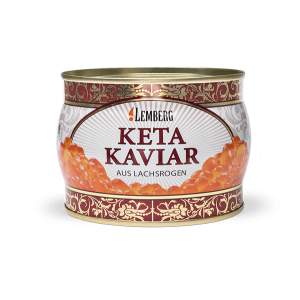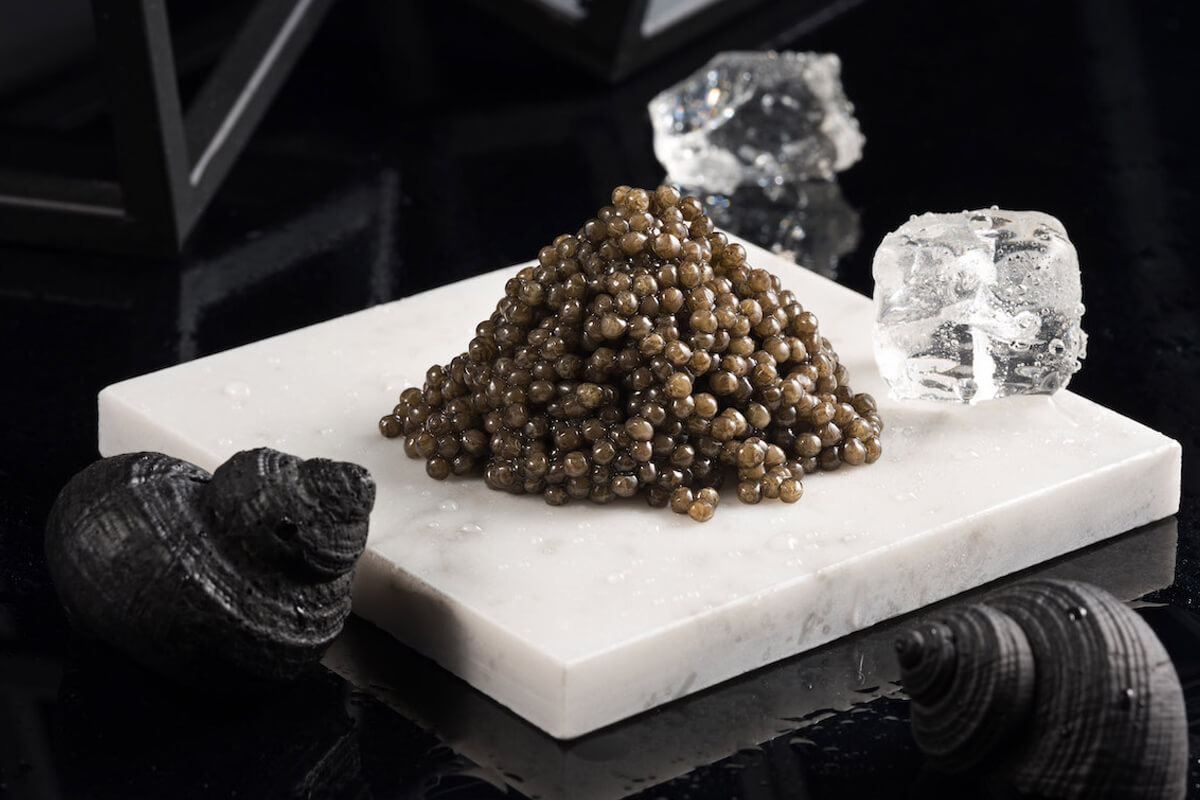HOW TO SERVE CAVIAR?
- Serving Caviar: Tips and Ideas
- The Best Way to Serve the Caviar
- Serving suggestions
- Caviar Garnish
- Drinks for Caviar
- Conclusion
Whether you want to enjoy the luxurious black caviar or prefer to opt for a less costly salmon caviar -, it is important to know how to serve caviar. Read on to learn what garnishes and drinks to offer to your party if you choose to indulge in this traditional delicacy.
Serving Caviar: Tips and Ideas
 Historically, the black caviar meant the fish roe of the wild sturgeon (the beluga) from the Caspian and Black Sea. Today, special caviar farms have sprung across the globe, producing the delicacy of tremendous quality.
Historically, the black caviar meant the fish roe of the wild sturgeon (the beluga) from the Caspian and Black Sea. Today, special caviar farms have sprung across the globe, producing the delicacy of tremendous quality.
It should be noted that not all caviar on store shelves is authentic. Various substitutes can be called "caviar" under US law. At Lemberg Caviar Shop, we pride ourselves on offering only authentic, top-quality caviar. Our selection is carefully curated to ensure that each product meets the highest standards of quality and authenticity, providing our customers with the genuine caviar experience they seek.
The serving of caviar is a meticulous art. Temperature plays a critical role in preserving its delicate flavor - too warm, and the oils overpower; too cold, and the subtlety is lost.
The Best Way to Serve the Caviar
When serving caviar, there are essential guidelines to ensure the best tasting experience. Firstly, caviar must be served cold, but not frozen. Storing caviar at room temperature can negatively impact its true flavor and aroma. Present it on a bed of crushed ice, which will maintain the correct temperature throughout your meal, allowing you and your guests to savor its authentic taste. This chilled presentation not only preserves its unique flavor but also maintains the delicate, rounded shape of each roe.
Secondly, it's crucial to avoid using metal plates or spoons when serving caviar, as metal can impart an unwanted metallic taste to this exquisite dish. Opt for glass or bone tableware, and for an extra touch of sophistication, consider a mother-of-pearl caviar set.
Serving suggestions
 Our company’s motto states that “With our low prices you can eat caviar by the spoonful!” Caviar is usually served as a starter, so there is likely to be enough for any party. Still, if you want your starters to be perfectly Instagrammable, then experts claim that half an ounce to an ounce is the right serving amount.
Our company’s motto states that “With our low prices you can eat caviar by the spoonful!” Caviar is usually served as a starter, so there is likely to be enough for any party. Still, if you want your starters to be perfectly Instagrammable, then experts claim that half an ounce to an ounce is the right serving amount.
In terms of etiquette, it is considered inappropriate or even impolite to consume large portions of caviar in one sitting. At social gatherings or events where caviar is served, remember to partake in amounts smaller than or equivalent to a tablespoon. Small servings ensure the enjoyment of its delicate, unique flavor in every bite.
Remember, caviar should not be served as a main course due to its rich and complex flavor profile. Using it as a component of a larger dish can overwhelm your taste buds, and consuming caviar in main course quantities is often prohibitively expensive. Therefore, we recommend serving black caviar as an appetizer or a starter, which is the traditional way to enjoy this gourmet delicacy.
Caviar garnish
Tableware and amount of delicacy sorted, you may be wondering what to eat caviar with? In fact, if you have splashed on the most expensive variety of black caviar, you are supposed to enjoy it without any complements. Still, if you feel there should be an accompaniment, then there are several foods you can choose from.
Eggs, sour crème, or crème fraiche are the top garnish choices. Their excellent creamy texture enhances the palate characteristics of caviar and brings out its unique flavor. Thinly chopped raw or spring onions provide an excellent barely-there sweet antidote to the caviar's slightly salty taste. Meanwhile, lemon is not recommended because its powerful sour taste will overwhelm the caviar. Likewise, extra salt is not necessary.
Caviar is usually served on thin buckwheat pancakes or small crunchy toasts, the latter adding that special "crunchiness" to the delicacy.
Drinks for caviar
In the realm of haute cuisine, the pairing of drinks with caviar is an art form that enhances the overall culinary experience. A popular and classic choice is vodka, particularly when served ice-cold. This crisp, potent spirit is revered for its ability to accentuate the caviar's pure, unadulterated flavor. The coldness of the vodka contrasts with the subtle warmth of the caviar, creating a harmonious balance on the palate. The alcohol’s clean, sharp notes cut through the richness of the caviar, allowing its delicate flavors to shine more brightly.
However, the elegance of Champagne also makes it a formidable contender in complementing caviar. The effervescence and acidity of a well-chilled brut Champagne can beautifully contrast and highlight the caviar's saltier nuances. The bubbles add a textural complexity that enlivens each bite, while the subtle yeasty notes in Champagne can bring out a new dimension in the caviar's flavor profile. This pairing is particularly celebrated for its ability to add a festive and luxurious feel to the dining experience.
Beyond vodka and Champagne, other pairings can also be explored. For instance, a dry, crisp white wine, like a Chablis or a Sauvignon Blanc, can complement the caviar without overpowering it. These wines, with their mineral undertones and citrus notes, offer a refreshing counterpoint to the caviar's richness.
In summary, when selecting a drink to accompany caviar, the key is to choose one that harmonizes with its luxurious nature and elevates its unique flavors, whether it be the classic choice of vodka, the celebratory Champagne, or an elegant white wine. Each pairing offers a distinct way to experience and enjoy the nuanced flavors of caviar, making the dining experience truly memorable.
Conclusion
Following the serving suggestions above is only the beginning of your caviar journey. Maverick chefs love to experiment and use it as a garnish to see how well it goes with other foods. But if you are new to the world of culinary exploits, we strongly recommend going down the traditional route and discovering the delicacy of tzars and emperors as it really is.
FAQ:
- How long can caviar last after opening?
Once opened, caviar should ideally be consumed within 2-3 days. Keep it refrigerated, but avoid freezing it, as this can significantly alter its texture and flavor.
- Can caviar be served as a main course?
Caviar is traditionally served as an appetizer or starter due to its rich flavor profile. Serving it as a main course is not recommended, as its strong taste can be overpowering in large quantities and it is generally more expensive.
- Is it necessary to use special utensils for serving caviar?
Yes, it is advisable to use non-metallic utensils, such as those made from mother-of-pearl, glass, or plastic, to serve caviar. Metal utensils can react with caviar and alter its flavor, giving it an undesirable metallic taste.
- What's the best way to serve caviar at a party?
For a party, serve caviar chilled on a bed of crushed ice, using non-metallic spoons. Offer it in small portions on blinis or crackers, accompanied by simple garnishes like crème fraîche and chopped chives. Pair it with chilled vodka or Champagne to enhance the experience.
Last update: 30.06.2025
Our bestsellers
More Recipes & Tips
Indulge in the exquisite flavors of Ossetra caviar. With its medium-sized eggs, this delicacy offers a buttery taste and a subtle hint of nuttiness. Elevate your dining experience with this luxurious treat, perfect for special occasions.
While the original Persian word khavyar simply means "egg," not every egg can be described as caviar. Some producers tend to apply this prestigious label to any type of roe from capelin to salmon and everything in between.
Caviar is one of the most delicious and healthy foods rich in protein and iodine. The high cost is due to the complexity of the production technology and the exquisite taste of the finished product. What is black caviar?
There are many different technologies for extracting caviar, depending on a variety of factors. And since a thorough discussion of this topic falls outside the scope of our article, we will only describe the most common method...

Indulge in the exquisite flavors of Ossetra caviar. With its medium-sized eggs, this delicacy offers a buttery taste and a subtle hint of nuttiness. Elevate your dining experience with this luxurious treat, perfect for special occasions.

While the original Persian word khavyar simply means "egg," not every egg can be described as caviar. Some producers tend to apply this prestigious label to any type of roe from capelin to salmon and everything in between.

Whether you want to enjoy the luxurious black caviar or prefer to opt for a less costly red variety, it is important to know how to serve caviar. Read on to learn what garnishes and drinks to offer to your party.

There are many different technologies for extracting caviar, depending on a variety of factors. And since a thorough discussion of this topic falls outside the scope of our article, we will only describe the most common method...

 Русский
Русский

